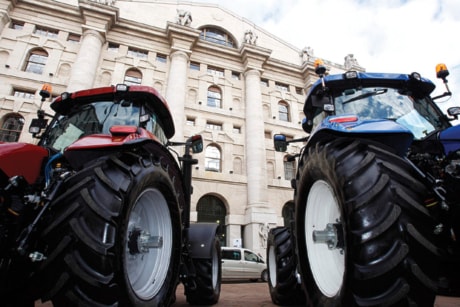MILAN, Italy — Italy’s Fiat is edging closer to becoming a global car maker. It has split off its farm equipment and truck business to focus on automobiles, and says it could take control of Chrysler this year.
The transformation at Fiat comes as Chrysler boosts sales, introduces new cars and prepares to take its stock public again after last year’s bankruptcy.
“I think it is possible, I don’t know whether it is likely, but it is possible that we go over the 50 per cent if Chrysler decides to go to the market in 2011,” Fiat CEO Sergio Marchionne, who is also CEO of Chrysler, told reporters Monday.
His comments came as Fiat Industrial began trading separately from the automaker. The 111-year-old company had been Italy’s largest industrial concern and employer.
The split with Fiat Industrial — which includes CNH agriculture and construction vehicles and Iveco trucks — is a key step toward achieving Marchionne’s goal of creating a global automotive player with Chrysler to build 6 million cars a year by 2014.
Fiat took a 20 per cent share in Chrysler LLC in 2009, gaining effective control after Chrysler emerged from bankruptcy. In exchange, Chrysler got small-car and clean-engine technology and Fiat’s management know-how.
Fiat expects to boost its Chrysler stake to 35 per cent this year by meeting three milestones.
To get to 51 per cent, Fiat would have to repay Chrysler’s loans from the U.S. and Canadian governments.
UBS analyst Philippe Huchois said that is “very likely,” anticipating repayment as early as the second quarter.
That, he said, would allow Fiat to buy the 16 per cent share it needs at a discount to what it will likely go for once Chrysler resumes public trading.
Huchois said it would be contingent on Chrysler’s refinancing a portion of the $6.9 billion it owes to the U.S. and Canadian governments, which would create savings in long-term interest. He expected Chrysler would refinance all but $2 billion, which comes due in October.
“They need to find banks willing to lend money,” Huchois said, adding that the improving U.S. auto market and Chrysler sales should help prospects.
Chrysler sales have risen faster than the U.S. industry clip boosted by new Jeep Grand Cherokee and other models. It prepares to roll out new models on smaller Fiat platforms and more fuel-efficient engines. Twelve models produced by Fiat or based on Fiat underbodies are planned for the next two years.
Marchionne’s next corporate move will be to get Chrysler back on the U.S. stock exchange, which he confirmed was likely in the second half of 2011. Analysts expect the companies to eventually combine although Marchionne repeated Monday he has no immediate plans to do so.
“A legal merger is not going to change our life,” Marchionne said, adding that the two companies are already integrated industrially.
Fiat has forecast the new auto company will have revenue of 64 billion euros by 2014 while Fiat Industrial revenues will be 29 billion euros.
He said separating the auto from the industrial businesses will allow each of them to operate with more clarity, and give them greater agility to seek alliances.
“Faced with the great transformations in place in the market, we could no longer continue to hold together sectors that had no economic or industrial characteristic in common,” Marchionne said at an opening ceremony at the stock exchange.
Marchionne has said he is on the lookout for alliances that will help the industrial and auto businesses thrive. He repeated on Monday that he does not need to sell assets to keep the businesses going, and has shrugged off Volkswagen’s expressions of interest in the struggling Alfa Romeo sports car brand, which he plans to launch in the United States. On the industrial side, potential partners include Daimler.
Marchionne’s plans to come out of the world economic crisis as a mean-and-lean global competitor has run into some labour resistance in Italy, where he wants to improve lagging productivity.
Fiat has reached deals for more flexible work rules in two key plants — Pomigliano near Naples and the historic Turin plant Mirafiori, clearing the way for two billion euros in investments.
Marchionne has made the more flexible work contracts — which, for example, add shifts and make it more difficult to strike during full production — a condition for his plans to invest a total 20 billion euros in Italy and double auto production. Much of that would be badly needed exports.
Marchionne has promised to raise salaries to reflect improved production.
But that has not persuaded one union holdout, FIOM, which says the plant-by-plant negotiations are undermining Italy’s system of national contracts.
While the deal for Pomigliano — where Fiat will make new Pandas — has been formalized over FIOM’s objections, the agreement in Mirafiori still faces a worker referendum later this month. FIOM has announced an eight-hour strike on Jan. 28 to protest the new contracts.
Marchionne has announced a joint venture at Mirafiori to build Alfa Romeo and Jeep brand vehicles, the first overseas expansion for Chrysler under Fiat’s stewardship.
